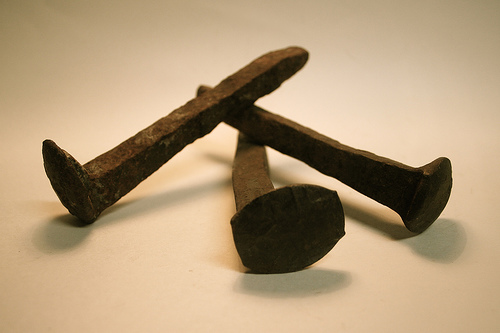| |
Unexplained Mysteries - Nail from the time of Christ's crucifixion found |
|
Source : http://www.mirror.co.uk/news/top-stories/2010/03/02/nail-from-the-time-of-christ-s-crucifixion-found-in-a-dig-115875-22079565/
 |
|
A nail from the time of Christ's crucifixion which was hidden by the same knights who featured in The Da Vinci Code has been found in a dig.
The four-inch Roman relic, stored in an ornate box, was uncovered by archaeologists working at a fort thought to have been a former Knights Templar stronghold.
It was buried with three skeletons and three swords, including one with the religious order's cross on its blade, on the tiny island of Ilheu de Pontinha, off Madeira.
The iron nail is of the type used in thousands of crucifixions - but it is special. Archaeologist Bryn Walters said: "It dates from the 1st to 2nd centuries. You'd expect the surface to be pitted and rough after so long. But this was smooth.
"It looks like it had been handled by a lot of people over a long period of time and the acid from their hands have given it a peculiar finish."
Yesterday Christopher Macklin of the Knights Templar of Britannia described last summer's find as "momentous".
He said evidence the nail had been handled a lot "indicates it was of great interest to many people". He believes the original Knights Templar thought it was a genuine artefact from Christ's crucifixion.
They occupied Jerusalem during the Crusades a thousand years after Christ, and claimed to be guardians of the Holy Grail, the cross and other relics. The Da Vinci Code portrays them as a modern secret society.
Jesus nails - What do we know about the nails?
We know that crucifixion was invented by the Persians about 300 or 400 years B.C. It was among the most painful and excruciating form of punishment leading to death ever contrived by man for man (women were never crucified). If we trace the word "excruciation" back to its origins we find that it is inextricably linked to the act of crucifixion: Latin excruciatus, past participle of excruciare, from ex- + cruciare to crucify, from cruc-, crux cross (Merriam Webster Dictionary).
Contrary to popular notion the nails which held Jesus to the cross must have been driven into His wrists and not his palms. Jesus' nails would have been made of heavy, probably square, iron material, 7-9 inches long. Many great painters from the past have depicted Jesus being nailed through His palms to the cross; it is a medical impossibility for this to be the case. You may have to really work your mind to grasp the enormity of what was going on here. The weight of a fully grown man was going to be suspended by three nails.
Not all crucifixions were carried out in the same way; some victims were tied to the cross while others were nailed. Jesus was nailed. He was made to carry the cross-bar to the place of His execution. The upright post (stipe) was a permanent fixture. The crossbar (patibulum) was always carried to the location, not the complete cross as is often depicted. When Jesus got to the place of His execution, He was placed on His back with His arms outstretched. The nails were first driven through small wooden disks to eliminate any chance of the heads pulling through the flesh. The site of the incision in the arm was critical; the Romans had perfected the procedure, a very specific procedure. The legionnaire who had been given the task felt for a specific spot, the nail had to be driven in-between the bones of the forearm up close to the wrist while not severing any major arteries or veins. There is a space between eight small bones which is structurally suitable to permit a full body weight to be supported for a time. If the nails had been driven into the palms of the hands, under the extreme weight, they would have ripped out between the fingers.
First, a nail would have been driven into His arm on one side, and then the other. The legionnaire would make sure that His arms were not pulled too tightly, allowing flexion and movement. With this done, the patibulum was then raised and affixed to the stripe. The next stage involved the nailing of the feet; this was also a deliberate action. The third nail had to be driven through both feet, which were turned outward so the nail could be hammered inside the Achilles tendon. With His knees slightly flexed Jesus was now crucified. As He slowly sagged down, He would have tried to support His weight with the muscles of His legs, an impossible position to maintain. In some cases, the victims' legs were broken, so that they couldn't support themselves in this way. Eventually more and more weight was placed upon the nails. The method the Romans had perfected ensured that crucifixion victims would hang painfully until their diaphragm went into spasm and they literally suffocated to death.

Discuss article |
Article Link
|
More unsolved mysteries on Unexplained Mysteries
|


![]()